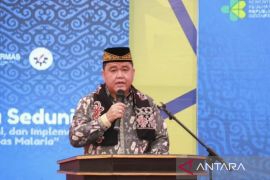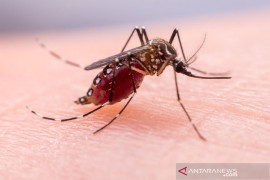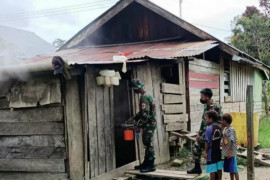The Asia Pacific Leaders Malaria Alliance has recorded that of the 80 percent of malaria cases in Indonesia, Papua province is the largest contributor to the deadly disease, followed by East Nusa Tenggara, Maluku and West Papua.Jakarta (ANTARA News) - Thousands of people in the Indonesian provinces of Papua, West Papua, East Nusa Tenggara, Maluku, and North Maluku are still at risk for malaria infection.
Malaria is a major public health problem in most tropical countries, including Indonesia with five of its provinces remain having high cases of this deadly disease.
Hence, the Indonesian Ministry of Health has appealed to the public, especially tourists who want to travel to eastern Indonesia to be wary of transmission of malaria.
Based on data from the Ministry of Health, malaria is still endemic in the provinces of Papua, East Nusa Tenggara, Maluku, North Maluku, and West Papua, because the elimination achievement of this deadly diseases in these five provinces is still zero percent.
Tourists, especially backpackers and adventurers who want to visit remote areas in eastern Indonesia, are advised to anticipate the transmission of malaria.
The most important anticipation is for the tourists to keep themselves from being bitten by anopheles mosquito, the cause of malaria.
In addition, the tourists are expected to be as much as possible not to go out at night, because anopheles mosquito is more active at night.
Even if the tourists have to go out at night, they should protect their bodies with lotions, and when they sleep, they have to use mosquito nets.
The Asia Pacific Leaders Malaria Alliance (APLMA) has recorded that of the 80 percent of malaria cases in Indonesia, Papua province is the largest contributor to the deadly disease, followed by East Nusa Tenggara, Maluku and West Papua.
APLMA is an alliance of Asian and Pacific heads of government formed to accelerate progress against malaria and to achieve an Asia Pacific free of malaria by 2030.
In East Nusa Tenggara Province, the local Health Office has recorded that as many as 29,000 malaria cases have plagued the communities in the islands province since 2016.
"A total of 29,000 malaria cases spread in 22 districts/cities in East Nusa Tenggara Province since 2016," provincial Health Office Chief Kornelis Kodi Meter remarked in Kupang on Wednesday.
He said the highest cases occurred in the district of Sumba Island, followed by Lembata, Ende, and Belu.
And, in the province of Papua alone, local Health Office has reported that four districts and the city of Jayapura remain endemic to the spread of malaria disease with a very high number.
Papua Health Office Chief Aloysius Giay remarked in Jayapura recently that the highest rate was recorded by the district of Mimika, followed by Keerom, Jayapura, and the city of Jayapura.
For that, Aloysius said his side was trying to reduce the number of malaria cases in these four districts and other areas in the province of Papua.
Interestingly, West Papua Health Office Chief Otto Parorongan remarked in Manokwari recently that the government of Teluk Bintuni District was quite successful in suppressing malaria cases.
Parorongan noted that the people in Teluk Bintuni District have been actively participating in the malaria elimination program for the last few years.
"The local Health Office involves the community as a health cadre, and volunteers are trained to provide early treatment of malaria," he said.
According to him, the antimalarial cadres in the oil and gas producing district are scattered in almost every village. In addition to diagnosing malaria in patients, they also give provisions in terms of drug delivery, prevention, and revitalizing the community movements.
In the meantime, the province of Maluku is fourth in the epidemic of malaria in Indonesia, so the local health department is trying to eliminate it.
"Hopefully, we can be free of malaria. The purpose of eliminating malaria disease in Maluku is to reduce the number of sufferers and fatality," Maluku Provincial Health Office Secretary Adonia Rerung said in Ambon on Sunday.
He said two districts and one city in Maluku with high rates of malaria transmission in recent years were Buru District, Central Maluku District and Ambon City.
He explained that people should continue to prevent malaria from spreading by leading a healthy lifestyle and by always cleaning up the mosquito breeding grounds.
"Hard work is needed to reduce the cases," he said, adding that the eradication of malaria had to be carried out from upstream to downstream, by maintaining a healthy environment, killing mosquito larva through fogging and with abate, regular blood tests and the use of mosquito nets.
Malaria, the worlds most important parasitic infectious isease, is transmitted by mosquitoes which breed in fresh or occasionally brackish water.
The symptoms of malaria include fever, chills, headache, muscle aches, tiredness, nausea and vomiting, diarrhea, anemia, and jaundice (yellow coloring of the skin and eyes).
Convulsions, coma, severe anemia and kidney failure can also occur. The severity and range of symptoms depend on the specific type of malaria.
In certain types, the infection can remain inactive for up to five years and then recur. In areas with intense malaria ransmission, people can develop protective immunity after repeated infections. Without prompt and effective treatment, malaria can evolve into a severe cerebral form followed by death.(*)
Reporter: Otniel Tamindael
Editor: Heru Purwanto
Copyright © ANTARA 2017











